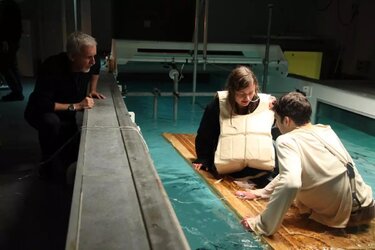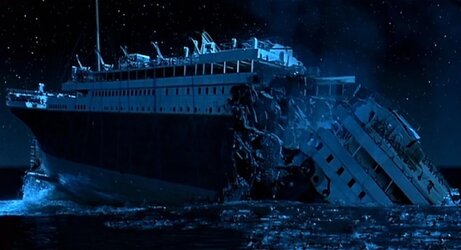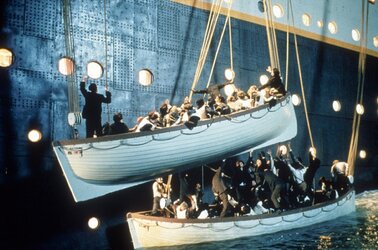JENNIFER OUELLETTE

Jack (Leonardo DiCaprio) sacrifices his spot on a makeshift raft to save Rose (Kate Winslet) in Titanic.
(Major spoilers for the 1997 film below. Psst: The ship sinks.)
Ever since James Cameron's blockbuster film Titanic hit movie screens in December 1997, fans have been arguing about a specific scene in which Jack (Leonardo DiCaprio) nobly gives up a spot on a makeshift raft to ensure Rose (Kate Winslet), the woman he loves, survives. Tired of constantly having to defend his artistic choice against claims that both lovers could have fit onto the raft, Cameron decided to re-create the scenario under controlled conditions in a new documentary for National Geographic: Titanic: 25 Years Later with James Cameron, marking the film's quarter-century anniversary.
For the 10 people on the planet who haven't seen the film, Jack and Rose are star-crossed lovers from different social strata who have the misfortune of consummating their love minutes before Titanic hits that infamous iceberg. (The characters are fictional, intended to humanize the tragedy by giving us someone specific to root for.) Much drama ensues, involving Rose rescuing Jack from a lower deck as the icy waters approach and engulf them and jumping off the lifeboat she briefly boarded because she can't imagine leaving Jack behind.
Thanks to Jack's cool head in a crisis, they survive Titanic's sinking. They end up splashing around in the icy waters with the other survivors until Jack finds a floating piece of debris and hoists Rose onto the makeshift raft. But when he tries to climb up too, the raft becomes unstable. Unwilling to risk her safety, Jack stays in the water, clinging to the raft's edge, and slowly freezes to death. Rose is rescued. Many diehard romantics were outraged at being robbed of their fairy tale ending, prompting heated debates and speculative theories about how Jack might have survived in the water long enough for them both to be rescued.
Cameron's commitment to getting every last historical detail right for Titanic is legendary—so much so that it led astrophysicist Neil deGrasse Tyson to take issue with the astronomical details depicted in the original film as Rose is floating on the open ocean, looking up at the stars. Cameron recalled receiving "quite a snarky email" from Tyson pointing out that we know the precise latitude and longitude for that day and time in 1912 and that the star field was incorrect. Tyson sent him the correct star field, and Cameron (to his credit) made the change in the 3D re-release of the film.

James Cameron supervises a cold and wet re-enactment of Jack and Rose on a makeshift raft.
But the question of whether Jack could have also been saved didn't have the same definitive answer. That's one reason it's still a matter of heated debate. It was even the subject of a 2012 episode of Mythbusters. Co-hosts Adam Savage and Jamie Hyneman conducted their own experiment and concluded that both Jack and Rose could have shared the raft and survived, provided they propped their upper bodies upright, and figured out how to attach Rose's lifejacket underneath it to increase the buoyancy. Cameron also appeared in the episode, telling the duo he thought they were "missing the point" and weren't accounting for just how difficult it would be to tie a lifejacket onto a floating piece of debris underwater when the water is 28° F.
"Had he lived, the ending of the film would have been meaningless," Cameron told Vanity Fair in 2017 on the film's 20th anniversary. "The film is about death and separation: He had to die. So whether it was that, or whether a smoke stack fell on him, he was going down. It's called art, Things happen for artistic reasons, not for physics reasons." Cameron said he spent two days on set testing the wood in the water to get just the right amount of buoyancy. He reasoned that Rose couldn't be immersed in the 28° water if she was going to survive one to three hours before being rescued. And he said he thought it was "silly" to still have the same debate after two decades.
It's now been 25 years and Cameron told the Toronto Sun in December that he had conducted a scientific study to "put this whole thing to rest and drive a stake through its heart once and for all." Two stunt people were chosen to represent Jack and Rose, with matching ages, heights, and weights. They were outfitted with three internal thermometers to monitor body temperature—if their temps dropped below 95° F, they were hypothetically dead— and proceeded to test several different scenarios with a re-creation of the makeshift raft floating in a tank of cold water (One hopes the stunt people were very well paid, because these were not comfortable experiments—even dangerous.) Cameron also re-created the Mythbusters' proposed scenario for good measure.
The answer was the same every time: either Jack or Rose could fit onto the raft and survive, but not both. (The Mythbuster scenario still had insufficient buoyancy, so "myth: busted," Cameron says.) But he does concede that there is at least one scenario in which Jack conceivably could have survived, with both Jack and Rose on the raft keeping their upper bodies (and cores) out of the water—it's just not one he considers likely. Factor in the violent shaking that occurred once "Jack" got onto the raft—and assuming Rose offered him her lifejacket—"he just might have made it," Cameron says. "But there are a lot of variables."
Also, Jack wouldn't have known what we know now about hypothermia, and he would not have had the advantage of running multiple experiments to find the best solution. "I think [Jack's] thought process was, 'I'm not going to do one thing that jeopardizes [Rose's survival].'" As Cameron pointed out, this is completely in character. Cameron's conclusion: "I should have made the raft smaller."
Cameron also revisited the accuracy of his re-enactment of the ship's fateful sinking: namely, whether or not Titanic split in two. In the movie, the bow sinks to the bottom first, and the stern splashes down to the water before rising up again to a vertical position and plunging into the icy depths. He based his depiction on the best information available at the time but has always wondered whether he got it right.

The documentary also revisits Cameron's depiction of the ship snapping in two.
To find out more, Cameron consulted with the US Navy for a computer simulation, which showed that the forces on the ship would have been sufficiently powerful when the stern was sticking up just 23 degrees out of the water for the ship to snap—not a full 90 degrees. Then he and his team built a model Titanic and practiced sinking it in a water tank under controlled conditions, relying on practical rigging and a few pyrotechnics to simulate the event. The result: Cameron was half right.
"We found out you can have the stern sink vertically, and you can have the stern fall back with a big splash, but you can't have both," he says in the documentary. "So the film is wrong on one point or the other. I tend to think it's wrong on the 'fall back of the stern' because of what we see at the bow of the wreck. I think we can rule in the possibility of a vertical stern sinking, and I think we can rule out the possibility of it both falling back and then going vertical."

As the ship continued to sink, lifeboats were being lowered practically on top of each other.
And what about the shortage of lifeboats? It's always been assumed that this was part of the fatal chain of events leading to the tremendous loss of life when Titanic sank. Rose explicitly asks Thomas Andrews (Victor Garber), the ship's builder, about the lack of lifeboats in the film. Cameron decided to test that theory too. He staged a re-enactment of the lifeboat deployment to determine how long it would take to deploy a single boat. His team managed to do so in eight-and-a-half minutes, which Cameron rounded up to about 10 minutes given all the unpredictable variables (including sheer panic). That means it would have taken at least two hours to deploy all the existing lifeboats, never mind any extras one might imagine could have saved more lives. Titanic sank in just one-and-a-half hours.
The film also depicts some lifeboats being lowered on top of each other as Titanic sank lower and lower into the ocean, with people in the boats frantically sawing through the davit ropes with pocket knives to avoid collisions. Cameron gamely volunteered to do the same, concluding, "Cutting davits with pocket knives is hard." So it's likely that even if there had been sufficient lifeboats, they would have just gotten in the way.
Titanic: 25 Years Later with James Cameron premiered Sunday, February 5, on the National Geographic channel. It is also available for streaming on Hulu, Fubo TV, and Direct TV Stream.